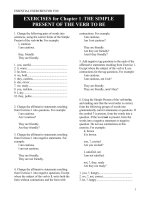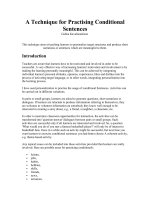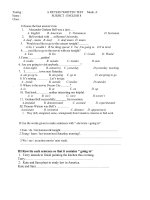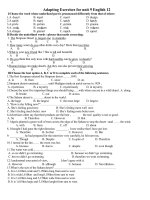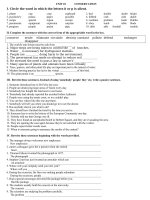Using Picture Dictation Exercises for Practising All Four Skills
Bạn đang xem bản rút gọn của tài liệu. Xem và tải ngay bản đầy đủ của tài liệu tại đây (57.28 KB, 2 trang )
Using Picture Dictation Exercises for
Practising All Four Skills
Sylvia Sao Leng Ieong
This exercise focuses on choosing or preparing a text in clear visual terms so that it can be
used for picture dictation, which involves learners in all four skills of listening with
attention, fun and interest, speaking with confidence, reading with care and purpose and
writing with accuracy.
Rationale
Dictation has never been popular with learners of English as a foreign language. However,
the picture dictation designed here, which sufficiently prepares learners for the activity,
involves students in all four skills of listening, speaking, reading and writing. It has been
extremely popular with pre-intermediate level learners and has proved very successful.
Success is always a good motivator for learners.
Steps
Normally the exercise takes about 20-30 minutes, depending on the length of the dictation,
in the following six steps:
1. Prior to the dictation exercise, the teacher chooses or prepares a text that is
appropriate to the level of the learners and is written in simple visual terms, like the
one quoted from John Haycraft:
There's an island in the middle of a lake. In the middle of the island there's a house
with a big door and four windows on the ground floor, and six windows on the first
floor. There're a lot of big trees to the left of the house. On the lake, to the right of
the island, there's a boat with two men in it. One of them is fishing.
To the left of the lake there's a hill with a church on the top. It's midday and the sun
is in the sky.
2. Listening with an immediate purpose, interest and fun:
The teacher asks two students (gradually more and more students will be eager to
volunteer) to come up to the black/white board, each using half of the board, and
draw what they hear while the teacher reads aloud the text to the class, explaining
contractions, prepositions, new or difficult words, plural nouns, etc., and even
writes them on the board if necessary. As these will be dictated later on, students
will listen with attention and interest and try their best to remember them. The
teacher can speak faster or more slowly depending on the students' response and
performance to ensure that learners can work and progress smoothly.
3. Speaking with confidence and pride:
After the teacher finishes reading aloud and the two students have completed their
pictures, the teacher asks the class if the pictures are correct. After corrections are
made, the teacher asks the two student artists to explain and talk about their
pictures. They are ready and proud to talk about their work in front of the class.
4. Listening again with understanding and writing with accuracy:
Now the teacher dictates the text in the traditional way while the students write on
sheets of paper or in their notebooks.
5. Reading with special care in order to locate mistakes:
Now the teacher displays the correct text using an overhead projector, PowerPoint
or the blackboard and asks the students to exchange their sheets or books to check
and correct each other's work.
6. The teacher may only need to do a sample check of students' work if the teacher can
trust their students to correctly make corrections.
Conclusion
Both pre-service student teachers and in-service teachers have tried this method with
beginners, pre-intermediate- and intermediate-level learners. Their response is very
encouraging. Learners like picture dictation because it is positive and interesting. When
they do the actual dictation they are already well prepared and find the work pleasant and
rewarding. Some teachers report that there are no more failures in this kind of dictation.
However, these teachers could not find enough appropriate texts or passages available for
picture dictation and they have difficulty in creating such texts suitable for picture
dictation.

